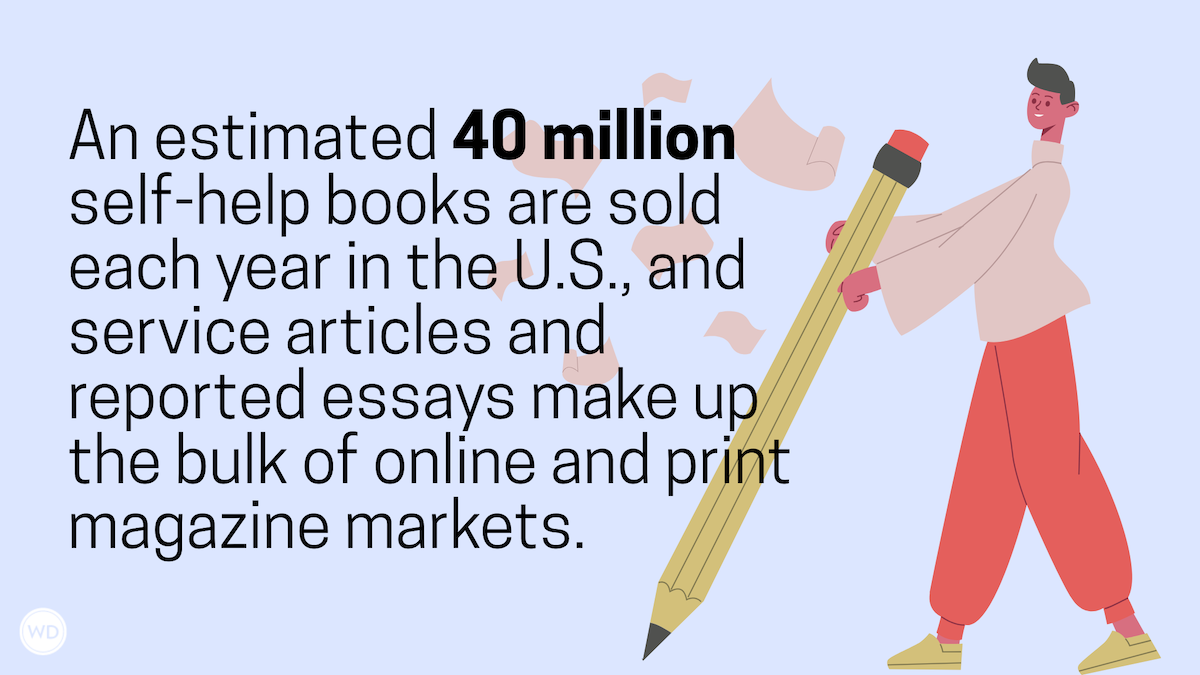WRITER'S DIGEST
P.O. Box 42534, Cincinnati, OH 45242
Email: writers.digest [@] aimmedia [.] com
Website: www.writersdigest.com
Our Mission
Writer’s Digest, the No. 1 magazine for writers, celebrates the writing life and what it means to be a writer in today’s publishing environment. Through the voices of bestselling authors, buzz-worthy newcomers, and seasoned editors, we offer everything writers need to stay inspired, to improve their craft, to understand the unique challenges of publishing today, and to get their work noticed. Our pages are filled with advice and real-life experiences that go beyond the ordinary and delve deeply into what’s important to writers today. Whether they write fiction or nonfiction, poetry or essays, articles or scripts, our readers will walk away from every issue inspired and ready to write, satisfied in the knowledge that we get it, that we all share this passion for writing, and we’re all part of a grand literary tradition. And that’s worth celebrating.
General Focus
Founded in 1920, such classic literary icons as Joan Didion, Ray Bradbury, Jack Kerouac, Truman Capote, H.G. Wells, Margaret Atwood, Maya Angelou, and more have shared their thoughts on different aspects of the writing life through the pages of Writer's Digest. We’re an instructive magazine that seeks to keep readers abreast of industry trends, of the latest writers who found success and what they did to achieve it, and of innovative ways to improve and empower the inner raconteur of our readers.
Our style is confident and authoritative, yet conversational. Our voice is that of an insider—your trusted friend in the business. Keeping informed on industry trends is essential to our readers’ success, so it’s essential for our editorial to address timely issues in publishing, and look forward to the future of writing in its myriad forms. Our goal is to provide readers with the inspiration, how-to instruction, and culturally relevant information they need to fulfill their writing goals and be a part of the larger community of writers.
Our Readership
Writer’s Digest is published six times per year, and has a paid circulation of 40,000 subscribers, while WritersDigest.com has 20 million pageviews/year. Our readers include people of all ages and varying levels of writing skill and success. We have a worldwide readership, but the majority of our readers live in the U.S. and Canada.
To obtain sample issues of Writer's Digest, you can purchase copies via the newsstand or www.writersdigestshop.com. An index of each year's contents is available at www.writersdigest.com.
How to Submit to Writer's Digest Magazine
We consider completed manuscripts on spec, as well as original pitches. A query should include a thorough outline that introduces your article proposal and highlights each of the points you intend to make. Your query should discuss how the article will benefit our readers, why the topic is timely and why you’re the appropriate writer to discuss the topic.
Although we welcome the work of new writers, we believe the established writer can better instruct our reader. Please include your publishing credentials related to your topic with your submission, along with a brief bio.
Please submit pitches to the print magazine using one of the pitch forms on the editorial calendar. If your pitch doesn't fit the issue themes, please submit your pitch using this general submission form (updated for 2026). Details for pitching WritersDigest.com are below. If you have clips available online, please include links. Accepted freelance articles must be submitted in electronic form, in text-only or Microsoft Word. We expect writers to thoroughly check all facts in their stories and to submit documentation to support the information included in their stories.
Because we receive hundreds of queries a month, please allow 2–4 months for a response. If you have a question about our submission guidelines, please email writers.digest [@] aimmedia [.] com.
Here are a few pointers to keep in mind:
- We don't accept or respond to queries via snail mail, phone, or fax.
- We don't accept pitches or articles generated by AI.
- We don't buy newspaper clippings.
- We don't buy reprints of articles previously published in other writing magazines or writing books.
- WD Interviews (our signature cover Q&A series) are almost always written in house. If you’d like to pitch an interview with a well-known author, we request that you get approval from the subject prior to your pitch.
- In today’s media environment, an article doesn’t just appear in print, but can become an interview on our podcast, a YouTube video, an extended blog post or a prompt for Facebook discussion. While it’s not required, writers who can cite supplemental ways in which their article might take shape in digital form will be given special consideration.
How to Submit to WritersDigest.com
Contributed articles and guest posts for online publication may be submitted to Senior Editor Robert Lee Brewer at rbrewer [@] aimmedia [.] com for review. Please include a brief summary of your proposed article or guest post, or attach a Word document containing a completed article, along with a headshot, bio, and any applicable book cover images. He will respond in a timely manner if the piece is a fit for the website.
Payment and General Terms
For manuscripts, we pay 50 cents per word, on acceptance, for first world rights for one-time print use and perpetual electronic use. Should we want to reprint anything we've purchased from you in anything other than electronic format, we'll pay you 25% of the original purchase price per use. Contributor copies are sent to writers and artists whose work appears in that issue.
We do not offer payment for unsolicited online articles and guest posts, except in rare cases when the content is highly focused or unique. In such cases, writers may be paid $50-$100 depending on the depth and length of the work. If payment is not offered, we may agree to include links to the author's website, social media accounts, and book outlets.
What to Pitch
Below are the spaces to pitch for the print magazine.
Inkwell
This upfront section of the magazine is the best place for new writers to break in. Each Inkwell features an 1,600–word lead story that kicks off the magazine. The article ranges in style and tone every issue, but often takes the form of an opinion-based or human interest piece, weaving a narrative and drawing out tips for readers. It can be a great place to discuss theoretical or timely concepts. Inkwell also features shorter articles of 1,200 words (trends, humor, insight on news that will still be relevant when our next issue hits stores, weird and intriguing tidbits about the writing world). Please note that all product and book reviews are handled in house—as are columns like Breaking In, Poetic Asides, and Worth a Thousand Words.
Author Profiles
These are profiles of prominent, specialized, or lesser-known authors that are placed in Inkwell, and can include both debut and veteran writers. They generally run at 800–1,200 words and must have a strong, unique angle of interest to writers. Please don’t pitch profiles on authors who’ve been recently featured in our magazine or other writing magazines.
Writing Technique Articles
These features highlight a writing method and detail how to use it successfully. Examples include how to write an effective lede, how to use dialogue to establish character, how to write a modern-day romance heroine, etc. They typically run between 1,200–2,500 words and may appear as a feature, in a column, or in Inkwell.
Articles may cover fiction, nonfiction, freelance, poetry, or scriptwriting techniques. Writers must have published successfully in the area they’re writing about. Every piece will need to:
- Define the technique and its importance.
- Break the technique down into distinct parts and deal with each part individually. When appropriate, use step-by-step explanation.
- Give relevant examples of its usage. Using examples is a vital part of technique articles. Illustrate points with examples—either from your own writing or from well-known works (preferably both). Avoid relying on movie plots for examples.
- Special consideration is given to technique articles that can be tied to the theme of the issue.
For All Ages
A 1,200-word, guest-written column about the craft of writing and the business of publishing for children, middle grade, and young adult readers (though we argue those books can and should be enjoyed by adults as well). Topics should be specific and written by those with experience in that area. Examples include: rhyming or page turns in picture books, advice for setting up school visits to connect with readers, using accurate and contemporary language and references for YA, etc.
On Nonfiction
A 1,200-word, guest-written column that focuses on all-things nonfiction. From instructional articles featuring tips for writing specific types of nonfiction (personal essays, memoirs, instructional or prescriptive nonfiction, history, etc.) to business considerations unique to nonfiction writers.
Market Reports
These are market reports highlighting publishing trends in a particular market. Genre reports detail what's changing or hot in a particular segment of the industry: fantasy, mystery or romance, for example.
There are several essential elements in market reports. Anecdotes, specific examples and quotes are important here, too. Interview and quote relevant sources. Describe the market including its target readership. Explain how to find ideas for the market. Point out how writers can generate salable ideas and provide tips on matching ideas to publications.
Also detail how to write for the market and describe the process of turning ideas into salable stories. What are the special requirements of writing for this market? Point out common pitfalls and how to avoid them.
Other Features
Please see our editorial calendar for upcoming topics. Query only if you feel you are the best person to write on each topic, and be sure to explain why.








